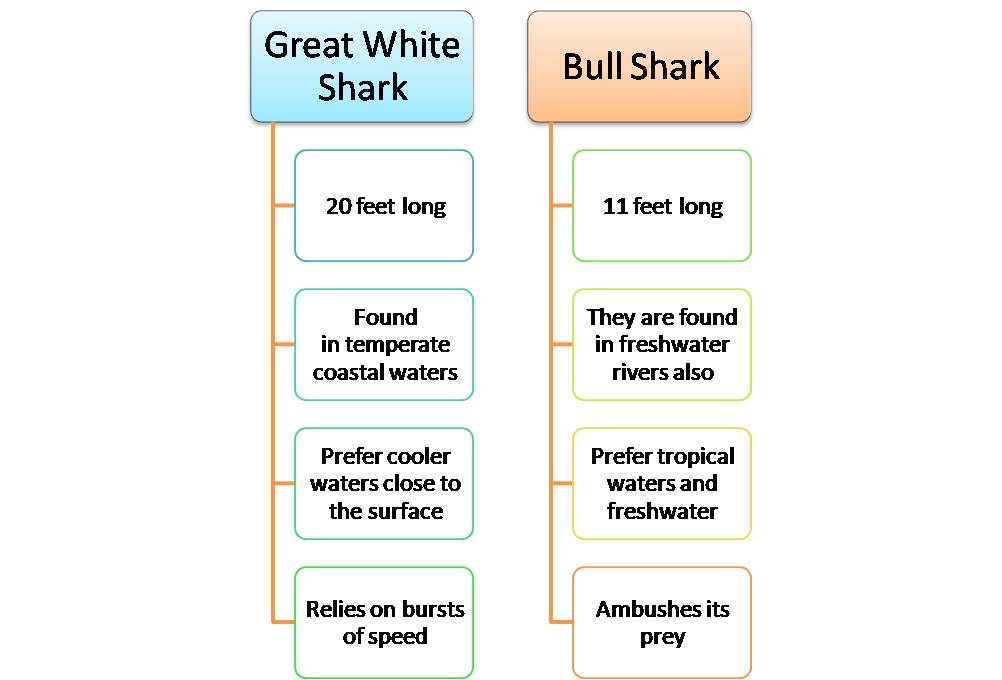Key Takeaways
- Great white sharks and bull sharks are two of the most feared and dangerous shark species in the world.
- Great white sharks are larger and can grow up to 20 feet in length, while bull sharks are smaller and typically reach lengths of 7 to 11 feet.
- Both species have powerful jaws and sharp teeth, but the great white shark has a stronger bite force.
- Bull sharks are known for their ability to survive in both saltwater and freshwater environments, making them more adaptable than great white sharks.
- Great white sharks are primarily found in coastal areas, while bull sharks can be found in rivers, lakes, and estuaries.
- Both species are apex predators and have a similar diet, consisting of fish, seals, and other marine mammals.
- Great white sharks are known for their spectacular breaches out of the water, while bull sharks are known for their aggressive and unpredictable behavior.
- While great white sharks are responsible for more recorded attacks on humans, bull sharks are considered to be more dangerous due to their ability to thrive in shallow waters where people often swim.
- Understanding the differences between these two shark species can help people make informed decisions about their safety when swimming or diving in shark-infested waters.
- Conservation efforts are crucial for both great white sharks and bull sharks, as they play important roles in maintaining the balance of marine ecosystems.
The ocean’s depths are the scene of a thrilling battle between two powerful predators: the Great White Shark and the Bull Shark. For centuries, humans have been captivated by their ferocity and presence. Let’s explore their distinct characteristics and unravel their mysteries!
The Great White has a sleek silhouette and rows of razor-sharp teeth – plus a formidable size and predatory instinct. The Bull Shark is different, with its robust build and ability to live in saltwater and freshwater. Both predators bring their own strategies to the table, making this battle even more exciting!

Ancient sailors told tales of massive sharks lurking beneath their vessels – and modern scientists venture into treacherous waters to study them. They’ve discovered more about their behaviors and ecological importance. By bravely pursuing knowledge, they continue to unlock the secrets hidden within the depths.
Prepare for an exploration like no other! We’ll venture into uncharted territories, where danger looms. Get ready to join us on a journey through turbulent waves and swirling currents, diving into the Great White Shark vs Bull Shark arena. It’s an epic struggle portraying nature’s perfect balance between strength and survival. Let’s chart new waters together and find out who will be the ultimate victor!
Physical Characteristics of Great White Shark and Bull Shark
Two of the most feared predators of the sea are the Great White Shark and Bull Shark. Both have distinct characteristics that make them perfectly suited for their environment.
- Size: Great Whites can reach up to 20 feet, while Bull Sharks average 11 feet.
- Shape: Great Whites have a streamlined body for speed; Bulls have a broader, flatter snout.
- Teeth: Great Whites have sharp triangular teeth; Bulls have stout, serrated teeth for crushing.
- Coloration: Great Whites have a greyish-white dorsal side to blend in above water, Bulls have countershading to camouflage when hunting.
- Smell: Both have an impressive sense of smell. A Great White can detect one drop of blood in 25 gallons!
These two species make the ocean their home, and they fight for survival every day.
Habitat and Range of Great White Shark and Bull Shark
Great White Sharks and Bull Sharks, two powerful predators of the deep, have different habitats and ranges.
| Great White Shark | Bull Shark |
| Great Whites are found in temperate coastal waters | Bull Sharks like a variety of habitats, including freshwater rivers. They can be seen around Australia, South Africa, and California. |
| Great Whites prefer cooler waters close to the surface | Bull Sharks venture into tropical waters and freshwater. Their versatility lets them live in tricky conditions and explore diverse regions. |
| Great Whites often travel long distances between feeding and breeding sites. | Bull Sharks are more local in their movements but they still cover large areas. |
A remarkable incident off South Africa saw a Great White and Bull Shark fighting for territory. This battle of giants revealed the strength and ferocity of both species. It proves their endurance and adaptability, which have been around for millions of years. The different habitats of Great Whites and Bull Sharks shape their personalities and behaviors. Knowing their preferences helps us appreciate the diversity of our oceans and emphasizes the need to protect these amazing animals for generations to come.

Diet and Hunting Behavior of Great White Shark and Bull Shark
Great White Sharks and Bull Sharks have separate diets and hunting behaviors. To explore these apex predators’ feeding habits, let’s check out their world.
Great White Sharks are well-known for preferring seals and sea lions. But Bull Sharks are more adaptable hunters, as they feed on different fish species in both marine and freshwater environments.
Here is a table of the diet and hunting behavior of these sharks:
| Diet | Great White Shark | Bull Shark |
|---|---|---|
| Prey | Seals, Sea Lions | Various Fish Species |
| Feeding Habits | Relies on bursts of speed | Ambushes its prey |
| Hunting Depth | Surface and mid-water | Shallow waters |
Notably, Great White Sharks have been seen eating dolphins and smaller shark species. Bull Sharks have the special ability to live in freshwater due to their salt retention capabilities.
When it comes to hunting behavior, research shows that these species have different personalities. Great White Sharks attack from below, while Bull Sharks bump into their prey before striking.
These facts come from studies conducted by experts. They show the diverse strategies used by these amazing creatures during hunts.
Size and Weight: The Great White Shark might be big, but the Bull Shark proves that size isn’t everything – it’s the fight in the shark!
Size and Weight of Great White Shark and Bull Shark
Great white sharks and bull sharks are renowned for their impressive size and weight. Let’s delve into these beautiful creatures!
| Species | Average Size | Average Weight |
| Great White Shark | 13-20 feet | 1,500-2,400 pounds |
| Bull Shark | 7-11 feet | 200-500 pounds |
These figures showcase the typical size and weight of great white sharks and bull sharks. It’s important to note that individual specimens may differ greatly.
When it comes to specifics, great white sharks have been recorded at up to 20 feet and over 2,400 pounds, making them one of the largest fish in the ocean. Bull sharks, on the other hand, are a bit smaller with averages of 7-11 feet and weights between 200-500 pounds.
Given their size and weight, it is essential to take some measures of precaution when coming across these intense predators.
- Avoid swimming alone or in areas with shark activity.
- In addition, don’t wear shiny jewelry or brightly colored clothing as this might catch their eye.
- Finally, if you find yourself near a great white shark or bull shark, stay calm and slowly move away without sudden movements.
Grasping the size and weight of great white sharks and bull sharks aids us in appreciating their stunning presence. By respecting their habitats and following safety precautions when needed, we can ensure an amicable relationship with these remarkable animals. These sharks have aggression levels that could go head-to-head with any professional sports team – no referee necessary!

Aggressiveness and Behavior of Great White Shark and Bull Shark
In 2015, divers witnessed a rare sight – a great white shark and a bull shark circling each other. They were showing their aggressiveness and territorial behavior.
Great whites are known for powerful attacks on seals and sea lions. Bull sharks have a notorious reputation for their aggressive behavior, often attacking humans in shallow waters.
Bull sharks are highly territorial, found in both marine and freshwater habitats like rivers and estuaries. They aggressively defend their territories from rivals.
Great whites primarily hunt by ambushing prey from below. Bull sharks have a unique hunting technique called ‘bump and bite’. They bump into their prey before biting down with powerful jaws.
Bull sharks have remarkable adaptability and can survive in both saltwater and freshwater environments. Great whites are known for their ability to breach out of the water while hunting or during predatory behavior.
Threats and conservation status – humans are the real predators. Great whites and bull sharks fight to remind us who the real kings of the ocean are.
Threats to Great White Shark and Bull Shark and Conservation Status
Let’s take a dive into the threats and conservation status of Great White Sharks and Bull Sharks.
| Threats | Conservation Status |
|---|---|
| Habitat degradation | Great White: Vulnerable |
| Overfishing | Bull Shark: Near Threatened |
Unregulated tourism activities can disturb their natural behavior and affect their well-being. To protect them, we need to support initiatives to preserve their habitats, use sustainable fishing practices, and raise awareness about the importance of marine ecosystems.
Let’s join together to safeguard our ocean wildlife. Every contribution counts! Let’s embrace our role as stewards of the ocean and prevent the loss of these majestic species!
Watch out for the Great White Shark and Bull Shark, they’re like the Kardashians of the ocean, always in fierce competition for the spotlight!
Interesting Facts and Records about Great White Shark and Bull Shark
The Great White Shark and Bull Shark are two fascinating creatures. Here are three facts about them:
- The Great White is the largest predatory fish around – it can reach 20 feet in length and weigh 5,000 pounds!
- The Bull Shark is much smaller, but it’s awesomely adaptable – it can survive both in saltwater and freshwater.
- Both of these sharks have powerful jaws with sharp teeth, but they have different hunting techniques – the Great White is stealthy and fast, while the Bull Shark uses its body to overpower its prey.
These sharks have a notorious reputation for unprovoked attacks on humans. To be safe, we must take steps like avoiding swimming alone in remote areas, respecting the sharks’ territories, and staying informed about local marine life. In this way, we can ensure safer interactions with these majestic creatures. In conclusion – the Great White vs the Bull Shark is like a classic gangster flick – full of teeth, size, and brute force!
Frequently Asked Questions
1. Which shark is larger, the Great White Shark or the Bull Shark?
The Great White Shark is generally larger than the Bull Shark. Great Whites can reach lengths of up to 20 feet and weigh as much as 5,000 pounds, while Bull Sharks typically grow up to 11 feet and weigh around 500 pounds.
2. What is the main difference between the Great White Shark and the Bull Shark?
One main difference between these two sharks is their preferred habitat. Great Whites are primarily oceanic sharks and can be found in coastal areas and open waters around the world. On the other hand, Bull Sharks are known for their ability to adapt to both saltwater and freshwater environments, often venturing into rivers and lakes.
3. Are Great Whites or Bull Sharks more aggressive towards humans?
While both sharks are capable of attacking humans, Bull Sharks are generally considered more aggressive and responsible for a larger number of attacks on humans. This may be due to their habitat overlap with recreational water activities in coastal areas and freshwater rivers.
4. Do Great Whites and Bull Sharks have different diets?
Yes, their diets differ. Great Whites primarily feed on marine mammals like seals and sea lions, as well as fish and occasionally other sharks. Bull Sharks have a more varied diet and consume a wide range of prey including fish, turtles, birds, and even land animals that accidentally enter the water.
5. Can Great Whites and Bull Sharks crossbreed?
No, Great Whites and Bull Sharks cannot crossbreed. They belong to different scientific families (Lamnidae for Great Whites and Carcharhinidae for Bull Sharks) and have distinct genetic differences that prevent interbreeding.
6. Are Great Whites or Bull Sharks more endangered?
Both species are currently listed as “vulnerable” by the International Union for Conservation of Nature (IUCN). However, Great Whites face a greater risk of extinction due to factors such as overfishing, habitat loss, and trophy hunting.
Conclusion
The Great White Shark and Bull Shark are two powerful contenders. In the end, only one can reign supreme. We have looked at their characteristics, habitats, eating habits, and human interactions. By analyzing these, we can decide which is the top predator in the sea.
Looking at their fight for the top spot, it’s clear that they have unique advantages. The Great White Shark is huge and strong. It can be up to 20 feet long and weigh over 3 tons. The Bull Shark has energy and agility – it can live in salt or fresh water. Both have a need to be at the top.
We haven’t looked at one important factor: intelligence. Research suggests the Great White Shark has more brain power than the Bull Shark. This gives it an edge when it comes to finding food and navigating complex marine areas.
One last thing: National Geographic reported Great Whites can jump out of the water when attacking seals near the surface. Showing their strength and hunting skills.
Reference:




